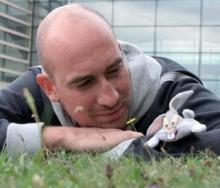
Abstract
In animals, olfaction playsa decisive role inlifebytriggering and guiding critical behaviours (mother-youngrelationships, food choices, avoiding dangers, etc.). In mammals, including humans, olfaction is known to be functional from foetallife, and to influence the first orientations of newbornsin contact with the maternal bodyas they undergo nipple searchingto ingest milk. Nevertheless, the chemical nature of the involved odours and the biological mechanisms underlying their processing and perception remain largely unknown. The European rabbit(Oryctolagus cuniculus)is the only species to date in which a pheromone emitted by the mother thatplaysa key role in the ability of newborns to locate the nipples and suck during the single and brief daily nursing occurringin thespecies, has been identified; This pheromone,the mammary pheromone (MP),has also a potentcognitive power by being able to promote, in an exceptionally rapid manner(1 trial, 5 min), the learning of new and initially neutral odours: 24h after pairingsuch an odour with the MP, newborn rabbitsrespond to the learned odour by displayingthe orocephalic behaviour allowing them to locate and orally graspthe nipples,as effectively as they do in response to the MP. This makes the rabbit a highly relevant animalmodel for studying both olfaction, pheromone perceptionand odourmemory.In this context, the NEONATOLF French-American proposal of basic research, which also aimsatan applied purpose, combines the strengths of 3 national (CNRL, CSGA, NutriNeuro Units) and 1 American (Duke University) partners, all experts in chemical senses and olfactory perception, in an unprecedentedmultidisciplinary work in this species ranging from proteomics to behaviour.It aims to unravel biochemical, physiological,and behavioural processes that contribute to the processing of the MP and new odours learned by MP-pairing to further characterize the memory and evaluate the consequences of these processes on milk intakein newborn rabbits.Our scientific program, basedon robust pilot data obtained within our consortium, will explore three original and currentquestions in rabbit biology: 1) How odour signals inducing an "innate" or a learnedbehavioural response,such as the MP or MP-pairedodours, respectively, are processed at the periphery of the neonatal olfactory system? 2) How the memory of new odours developsin newbornsin the context of direct (MP-induced) or indirect (sensory preconditioning) learning procedures? 3) What consequences the peripheral processing (reception, transport, metabolism) of the MP and MP-learnedodourshave on sucking success and survivalin pups? We now have sufficient theoretical/technical experience and expertise to provide innovative results in this domain. In basic research, the outcomes of this project will have relevance for all scientists interested in animal perception of biologically-significant stimuli contained in the environment, which is highly complex and dynamic, such aschemists, ecologists, ethologists, neurobiologists,and psychologists. By promoting a better understanding of odour perception in newborn rabbits, the project will also have adirect relevance to developingmultiple odour-based strategies that allowresearchersto address the problem of neonatal mortality,which is high in rabbit farming and emotionally and financially painful for breeders. Moreover, odour-based strategies may be useful to optimise the difficult transition from milk to solid food when the pups are getting older (around weaning). Finally, bycharacterizing certain biological processes that are crucial for the youngto interact with theirmotherat birth, the project will provide the general public with a new vision of this weakly-known animalbyhighlighting itsremarkable sensory, cognitive,and behavioural skills.











